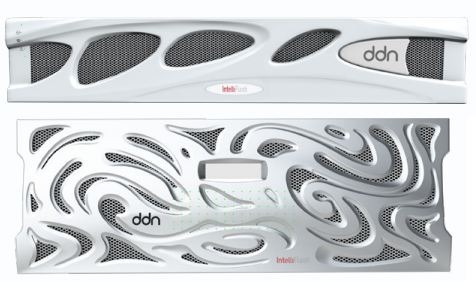Overview:
H-Series Storage Systems
The IntelliFlash H-Series intelligent infrastructure is a fourth-generation storage solution that delivers an exceptional user experience through automation, analytic insights, and a variety of time-saving management features to drive your most valuable workloads in today’s data centers.
The IntelliFlash H-Series hybrid flash systems combine the performance of NVMe with the economics of HDDs for a full-service intelligent storage infrastructure that’s easy to manage and delivers exceptional value. H-Series systems enable multi-petabyte, multiprotocol environments that support virtualized and nonvirtualized SAN and NAS workloads.
These systems deliver an ideal combination of performance and scalability for enterprise end-user file shares and AI, analytics and HPC workloads. The H-Series enables concurrent support for SAN and NAS protocols on a single system for cost-efficient workload consolidation, while incorporating powerful analytics software for faster data insights. These enterprise-grade systems also enable large scale file services without the performance degradation experienced when using other NAS systems.

More Performance, More Scale

Cost-Effective On-Demand Scalability

Large-Scale File Services
Product Overview:
Performance That Scales for NAS Workloads
- Leverage NVMe flash to boost performance with an optimized flash-to-disk ratio
- Modular scalability with highcapacity expansion shelves
- Native data reduction boosts economics for secondary workloads
- Application-aware and easy-tomanage
Specifications:
| Product Specifications |
| Model |
H6100 |
H6200 |
| NVME Raw Capacity (TB)A |
46 to 368 |
| HDD Raw Capacity (TB)A |
96 to 2016 |
360 to 5040 |
| Hybrid Effective Capacity (TB)B |
384 to 8064 |
1440 to 20160 |
| Storage Controllers |
Dual Controller (active/active), fully redundant architecture |
| Ethernet Data I/O Ports |
Up to 8x 40/100GbE or 8x 10/25GbE |
| Fibre Channel Data I/O Ports |
Up to 8x 16 Gbps Fibre Channel |
| Network Admin Ports |
4x 10GbE, 2x 1GbE (IPMI) |
| Controller Form Factor |
2RU (24x NVMe SSDs) |
| Controller Physical Dimensions |
3.4” x 17.6” x 33.5” (87.6mm x 446.4 mm x 850mm) |
| Weight (Estimated) |
Controller: 80lbs (36.2kg) (chassis only) and 91lbs (41.2kg) (fully populated with 24x SSDs) 24-bay expansion shelf: (64 lbs (29.0kg) (chassis only) 103 lbs (46.7kg) (fully populated with 24x HDDs) |
Controller: 80lbs (36.2kg) (chassis only) and 91lbs (41.2kg) (fully populated with 24x SSDs) 90-bay expansion shelf: 91lbs (41.2kg) (chassis only) 233 lbs (105.8kg) (fully populated with 90x HDDs) |
| Environmental Specifications |
Operating temperature: 10 C to 25 C (50 F to 77 F)
Non-operating temperature: -40 C to 70 C (-40 F to 158 F)
Operating relative humidity: 20% to 90% (non-condensing)
Non-operating relative humidity: 5% to 95% (non-condensing) |
| Expansion Shelves Supported Per System |
6 |
4 |
| Software Services |
|
| Block and File Protocols |
SAN Protocols (iSCSI, Fibre Channel), NAS Protocols (NFS, SMB) |
| Capabilities |
IntelliFlash Operating Environment:
Real-time deduplication and compression, snapshots and clones, space efficient thin provisioning, synchronous replication, full featured file services, S3 Cloud Connector, Live Dataset Migration, data-at-rest and data-in-flight encryption |
| Management |
IntelliFlash web UI, configuration wizard, Analytics for IntelliFlash, VMware plug-in for vCenter and support for vCenter Linked Mode, RBAC, SRA |
| Hardware Availability |
Redundant storage controllers, fans, power supplies, and network ports; removable SSDs and HDDs, SAS expansion |
| Warranty |
| Basic |
24×7 support via email and phone, next business day hardware replacement for defective parts and software updates for the first 90 days. |
| Optional |
Standard/Premier Service: ddn.com/support/support-plans | tintri.com/company/support/intelliflash-support |
a. Values indicated are RAW capacity. One MB is equal to one million bytes, one GB is equal to one billion bytes and one TB equals 1,000GB (one trillion bytes) when referring to storage capacity. Accessible capacity will vary from the stated capacity due to formatting and partitioning of the hard drives, the operating system and other factors.
b. Effective capacity assumes capacity after dual-parity, data protection, and metadata overhead, and includes the benefit of data reduction with inline deduplication and compression. Data Reduction is calculated based on 4:1 ratio. This efficiency can differ based on workload and or expansion shelf configuration. Where a range is present, the values are Min - Max.
| Intelliflash H-Series Expansion Shelves |
| Model |
H6100 |
H6200 |
| HE-192 |
HE-336 |
HE-720 |
HE-1260 |
| Shelf Type |
24-Bay SAS HDD Expansion |
90-Bay SAS HDD Expansion |
| Supported HDD Media Size (TB) |
8 |
14 |
8 |
14 |
| Raw Capacity(TB)A |
96 to 192 |
168 to 336 |
360 to 720 |
630 to 1260 |
| Effective Capacity(TB)B |
768 |
1344 |
2880 |
540 |
| Expansion Shelves Supported Per System |
6 |
4 |
| Physical Specifications |
|
| Expansion Shelf Form |
4RU |
| Physical Dimensions |
17.2”(H) X 13.7” (W) 6.9” (D)
(438MM (H) X 347MM (W) X 174.4MM (D)) |
6.9”(H) X 17.56” (W) 42.52” (D)
(175.3MM (H) X 446MM (W) X 1080MM (D)) |
| Weight |
24-bay expansion shelf: (64 lbs (29.0kg) (chassis only)
103 lbs (46.7kg) (fully populated with 24x HDDs) |
90-bay expansion shelf: 91lbs (41.2kg) (chassis only)
233 lbs (105.8kg) (fully populated with 90x HDDs) |
| Environmental |
Operating temperature: 0°C to 35°C (32°F to 95°F)
Non-operating temperature: -20°C to 60°C (-4°F to 140°F)
Operating relative humidity: 20% to 80% (non-condensing)
Non-operating relative humidity: 10% to 90% (non-condensing) |
Operating temperature: 10°C to 35°C (50°F to 95°F)
Non-operating temperature: -40°C to 70°C (-40°F to 158°F)
Operating relative humidity: 20% to 90% (non-condensing)
Non-operating relative humidity: 5% to 95% (non-condensing) |
a. Values indicated are RAW capacity. One MB is equal to one million bytes, one GB is equal to one billion bytes and one TB equals 1,000GB (one trillion bytes) when referring to storage capacity. Accessible capacity will vary from the stated capacity due to formatting and partitioning of the hard drives, the operating system and other factors.
b. Effective capacity assumes capacity after dual-parity, data protection, and metadata overhead, and includes the benefit of data reduction with inline deduplication and compression. Data Reduction is calculated based on 4:1 ratio. This efficiency can differ based on workload and or expansion shelf configuration. Where a range is present, the values are Min - Max.



